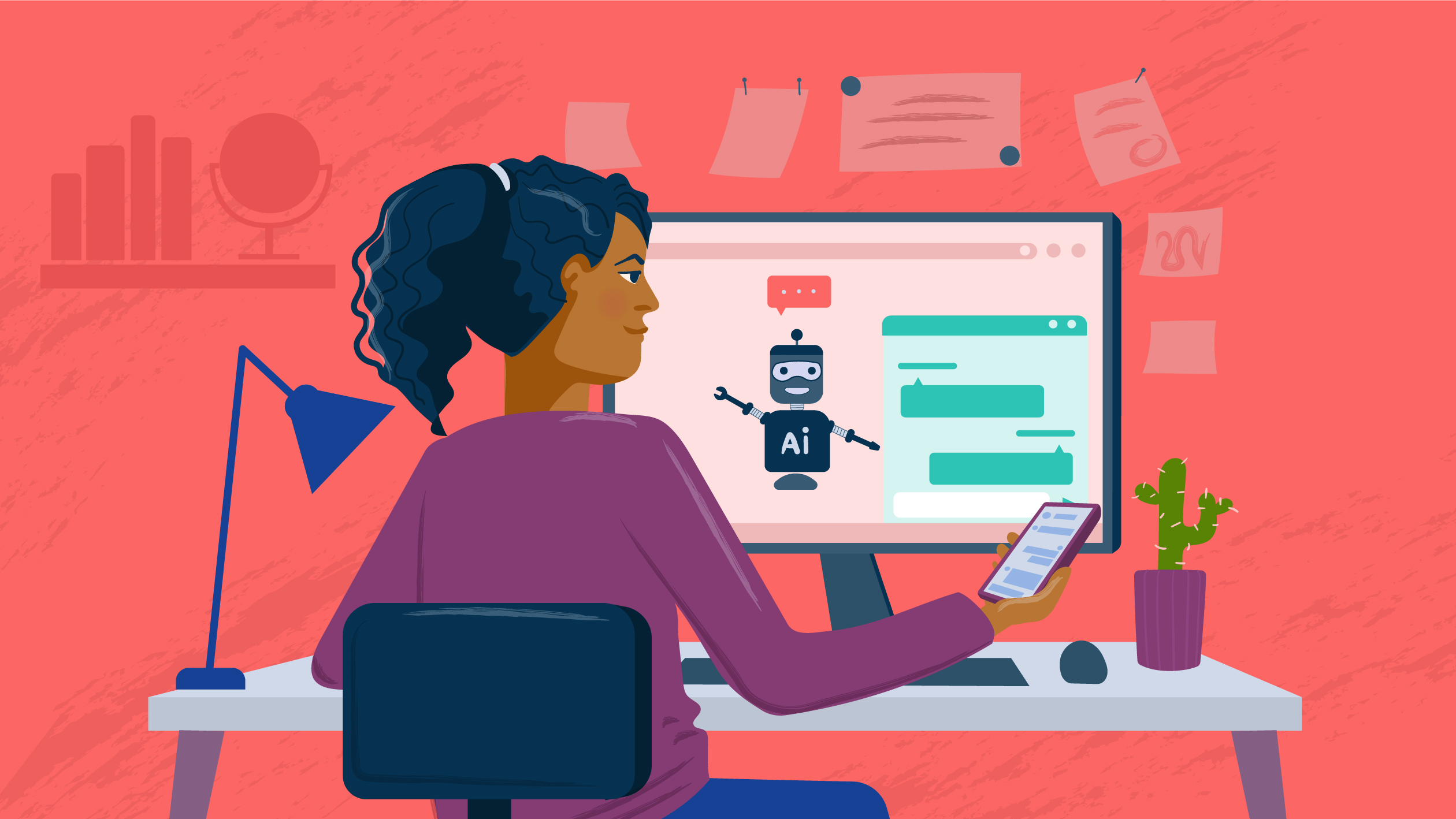
Illustration by Madalina Pavel (Picturise)
Digitalisation and AI in the youth sector: reality or hype?
by Veronica Ştefan
This is an interpretation of the journey of the youth sector in an ever-changing landscape, where digital transformation and artificial intelligence are increasingly mentioned. What do we make of it and what are the topics we should really care about? This is not an exhaustive account of everything that has happened in the youth sector in connection with these topics, nor a mapping of all the resources published. It is just an attempt to summarise the efforts done to demystify digitalisation in the youth sector and is an invitation for future reflections.
 Episode 1. The global pandemic – creative islands and everyday realities
Episode 1. The global pandemic – creative islands and everyday realities
Once upon a time, not so long ago, a global pandemic forced us to shut down. Leaving most of us in early 2020 with two options – either stay at home, isolated, or turn to digital tools and environments as the only possibility to regain some “normality”.
At first, for the youth sector, this didn’t seem much of a problem. After all, digital youth work or smart youth work were not new concepts. In 2018, various Youth Partnership events and publications were already connecting the dots and showcasing the many faces of digital transformation and how it impacted young people – whether it was about policies, youth work practices, new ways of communicating and working, or new forms of activism.
So, why, when Covid-19 struck, were 91.3% of world learners still impacted?
The Youth Partnership 2020 Study on social inclusion, digitalisation and young people, but also more specific papers published after the pandemic (V. Ştefan and A. Şerban; M. Di Paola), highlights how the youth sector showed proof of great spirit and innovation, while still facing the need for major structural changes such as strong youth policy frameworks, relevant digital strategies and mechanisms that could have supported real digital transformation – from creative islands to everyday realities.
So, we could conclude that the youth sector was not exactly ready to deal with the new digital reality, but it was definitely ready to be part of the solution to one of the biggest crises of the century. The collection of ideas and practices included in the 2021 Youth Knowledge Book #27 is a testament to that; it provides inspiration to anyone interested in developing new practices or policies connected to new forms of learning, digital well-being of young people, support for young people with fewer opportunities, or management of new risks from the use of digital technologies.
 Episode 2. All is good in the hood – digital is the new reality
Episode 2. All is good in the hood – digital is the new reality
As we learned to navigate the global pandemic, we also learned to become more proficient in using the new technologies; at the end of the day, they became vital, at least in the first two years of the pandemic. That’s how, as young people or youth workers, we never met, but we always had an online call, quite often more than once a day, about our professional or family life. The communication app Discord started being our go-to-community, whether we were a passionate e-gamer or a youth worker.
So, by now, we could assume that we have all become some sort of digital “guru”. Or have we?
The easy answer would be, of course, aren’t we online all the time?! As the studies mentioned above show, we use the internet and devices on a daily basis for different reasons. In 2019, just 1% of young Europeans had never used the internet. At the same time, 86% of young people who used it on a daily basis would mostly use it to connect to social networks. Much fewer would use it for more purposeful actions – just 31% use it to search or apply for a job, and 13% to take part in an online consultation.
Why is this relevant? The mere use of technology doesn’t transform us into competent users and it doesn’t necessarily lead to more meaningful engagements.
There are at least three effects that the pandemic brought in relation to our digital behaviours that should be further considered:
- It created the feeling that all of us who “survived” the pandemic gained advanced digital proficiency, while in many cases we were basic users of digital tools, with just more awareness of the existing digital tools.
- It created the assumption that whatever happened during the pandemic was the real digital transformation, ignoring the fact that many solutions used or developed in the pandemic were a crisis response and not a well-planned/sustainable process.
- It created the impression that digital transformation is an irreversible process, potentially implying that there will be a sustained and accelerated process of adopting new technologies.
Being aware of these effects is very important, especially in the aftermath of the pandemic. Practice already shows that there is an expressed need to leave behind the “new digital normal”, since many of the newly acquired digital habits were harmful for individuals – for example due to a lack of digital hygiene, excessive use of technology, lack of support and sustainable measures. As many of the new practices were the result of improvised actions or created under the pressure of the pandemic, they lacked strategic steps. In this context, it is more important than ever to discuss developing policies, strategies and frameworks that could support the development of digital competences (of young people and youth workers), as well as digital capacities (of their organisations).
To all this, we need to add a critical perspective where digital transformation in the youth sector supports both the positive use of digital technologies, and a critical mindset in understanding that technologies can bring additional risks and negative consequences. Youth work and techlash – What are the new challenges of digitalisation for young people? and Technology and the new power dynamics: limitations of digital youth work are some of the papers which address many of these issues and raise questions to which the youth sector has yet to find responses.
 Episode 3. From digitalisation to artificial intelligence – how did we end up here?
Episode 3. From digitalisation to artificial intelligence – how did we end up here?
Before the pandemic, smart and digital youth work were mostly seen as optional or ideal by many youth stakeholders, but things have changed. To a large extent, the youth sector has understood the importance of digital transformation, it is more familiar with the concepts and practices behind it and it can have meaningful conversations on all topics related to it. In this context, contributing to debates about the impact of AI in society can be seen as complementary to the role already assumed by youth actors.
Wait! I thought we were discussing digital transformation or digitalisation – where did AI come from? Didn’t we just say that meaningful and sustainable use of digital technologies is something we still struggle to deal with, within the youth sector? What is the connection with AI?
Fair points. Most people in the youth sector (policy makers, youth workers and youth leaders) who are exposed to the European discourse feel like they are playing catch-up, learning new terminologies, trying to connect the different processes and identify the relevance for the youth sector. Yet, it seems that a new buzz word requires their attention every year.
Believe it or not, AI is not a by-product of the Covid-19 pandemic, it’s not even a terminological replacement for digital transformation. AI was relevant for economic and competitiveness reasons – part of the global race for innovation – with few youth, education or social stakeholders engaged in its development. In time more research indicated that some of the AI-powered technologies can negatively impact fundamental rights, especially of vulnerable groups. Global and European policy makers and human rights advocates began to pay more attention to it.
Is there a role for the youth sector in this AI story?
Efforts go into responding to this exact question, at the same time trying to propose pathways in which youth stakeholders could be more active in shaping the policies and new AI technologies created. Shapers & Shakers: Young people’s voices in the world of artificial intelligence and Precarious youth and the spectre of algorithmic stereotyping offer a more detailed perspective on how AI developments could impact the youth sector and more specifically youth rights. They provide a good overview for anyone interested in having an informed opinion to join today’s AI debate and contribute to the development of European policies and regulations in the field. Automating youth work: youth workers views on AI provides further ideas for those who want to focus on the role of youth workers. Admittedly, they are not easy reading, especially if this is your first time trying to get close to this topic.
Is there a chance that AI is just another buzzword, a hype of the moment?
Maybe, very few could say with certainty which new technologies will stay in the public attention or which one will gain more momentum. Nevertheless, AI should not be ignored. The studies mentioned above highlight how such technologies have started to be used by both private and public institutions, very often lacking transparency or full awareness of how that technology works. AI is being developed and used at a very fast pace and the youth sector needs to follow its impact. In the absence of policies, and especially stakeholders who know how to identify harmful situations, it can become dangerous for the democratic and social fibres of our societies.
Can it all be that gloomy? With the pandemic we’ve just learned to embrace digital technologies – should we now take a different approach?
AI is one of the most pervasive technologies today – it’s virtually everywhere. It is not possible to run away from AI (from the algorithm used on social media, the one used when you go shopping, to the potentially automated decision taken by police, a criminal court or social welfare institution). That’s why we cannot really talk about an “either/or” paradigm –embracing or running from a technology. The real need is to further invest in critical digital literacy, where we understand its benefit and can identify positive use, while also anticipating the risks and potentially knowing where to find remedy.
ChatGPT is one of the most eloquent recent cases we have. Starting with November 2022, when it gained popularity, the question was – should we use this AI technology for creative/productive purposes or should we forbid it since in some contexts it leads to unfair practices (e.g. students cheating in their homework, organisations using it to write their projects)? Both were legitimate perspectives, firstly, because such technology (general purpose AIs or generative AIs) can bring added value to our work and this cannot be denied; secondly, because while the use of the technology can lead to unfair behaviour, the technology might be banned in some circumstances (e.g. forbidden in schools). It is not just a basic algorithm that shows preference for one article/product instead of another, but it can actually invent wrong or fake facts/situations – the so-called “hallucinations”. Simply put, ChatGPT just like many AIs has problems in the way it works – how it makes decisions is often unknown to the developers themselves (black box), the data it uses can be biased or insufficiently representative for society/a group of citizens. Such technology is tasked to produce the best result they are capable of; they are not sufficiently “trained” before they are launched in the public space. Can you imagine your doctor using ChatGPT to analyse your health results and propose a diagnosis, just based on that? It might already be happening and you are just not aware of it.
 Epilogue
Epilogue
If you managed to stay with me until now, I guess we can all agree that digital technologies are part of our lives, no novelty here. I will not have any new enlightening conclusions for you though.
Yet, while we can argue that digital youth work is complementing and not replacing youth work, the pandemic has shown how valuable digital technologies can be. Maybe this time we don’t wait for another pandemic to learn how to use a new digital tool, but we take proactive steps to grow our competences and capacities to plan and implement meaningful digital youth work.
Easier said than done, I know. We still need policies and resources for it. But more than that, we need a voice in the youth sector to ask for it and be aware of its importance – beyond the innovation and crisis-response approach.
One final thought, as highlighted by many of the Youth Partnership resources that you can access on digitalisation and AI, the youth sector should engage in shaping technologies and policies that govern them. We still have to figure out how to do it. It might not be our usual cup of tea, but it is the one that needs our attention.
Technology is increasingly intertwined with human rights. So, whether you are a policy maker, youth work provider, youth activist, researcher or educator, take a bit of time to advance this priority too, starting with reading and learning about it, or if you are really lucky, by discussing it with someone in your organisation. There is a lot of hype behind it, but it’s also so incredibly present in our realities.

Veronica is an international expert working intensively at the intersection of education, policy and new technologies.


